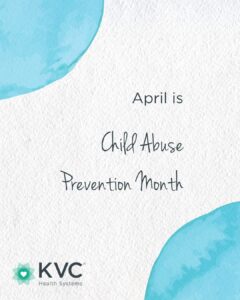Youth Protection: Preventing Abuse and Neglect in Nebraska

Every individual deserves to grow up feeling safe, loved and supported. Yet for too many children, these foundational rights are out of reach. Child abuse and neglect are harsh realities that impact millions of young lives every year, including many right here in Nebraska. Each statistic represents a youth in need of protection and a family in crisis. But there is hope: each statistic also signifies a community with the power to make a difference.
April is Child Abuse Prevention Month, a time to shine a light on this critical issue and unify behind the efforts to protect vulnerable children and support struggling families. At KVC Nebraska, we believe everyone deserves connection. In that spirit, we’re working to spread awareness, take action and build stronger communities, creating a safer, healthier future for all. Let’s take a closer look at what this looks like in Nebraska and what each of us can do to prevent it.
The State of Child Abuse in Nebraska
 More than 550,000 children and youth in the United States have experienced abuse or neglect, with an estimated one in four girls and one in thirteen boys experiencing abuse. These cases are uncovered and addressed because of the hardworking professionals in child protective services and agencies like KVC, who commit themselves to aiding children, teens and families in crisis.
More than 550,000 children and youth in the United States have experienced abuse or neglect, with an estimated one in four girls and one in thirteen boys experiencing abuse. These cases are uncovered and addressed because of the hardworking professionals in child protective services and agencies like KVC, who commit themselves to aiding children, teens and families in crisis.
While Nebraska has some of the lowest rates of child abuse in the country, it is still a serious issue that needs to be addressed to protect youth and families. In 2023, Nebraska saw 1,732 substantiated reports of child abuse, a 6.5% decrease from the previous year. Of these cases, more than half occurred with children seven years old and younger, with 13% occurring with infants under one year of age. The most common perpetrator of the abuse was a biological parent, comprising 75% of cases.
Risk Factors
What are the risk factors for child abuse? Tragically, child abuse is prevalent no matter the circumstances, it impacts youth across socio-economic statuses, neighborhoods and demographics. Many risk factors can be connected to cases of abuse and neglect, from difficult life circumstances to a lack of a strong support system. Here are some of the most common risk factors that may lead to child abuse or neglect:
- Poverty (13.8% of youth in Nebraska are living at or below the poverty line)
- Substance abuse by the caregiver
- Mental health challenges in the household
- A family history of domestic violence, or other types of violence in the home
- A lack of knowledge or education on the part of the caregiver (i.e. not understanding the youth’s needs or development)
- Isolation or a lack of community support
These risk factors do not guarantee an abusive or neglectful situation, but they do make families more vulnerable to crisis. Addressing these risk factors through family empowerment services, advocacy and systemic change is key to preventing abuse and neglect in our state.
Impact of Child Abuse on Children
Child abuse can have numerous long-term and short-term impacts on the children and youth who experience this trauma. Here are some potential negative outcomes for youth who experience abuse or neglect.
 Mental Health Outcomes: Child abuse has a direct impact on a child’s mental health. Children and teens may experience depression, anxiety, post-traumatic stress disorder and even suicidal ideation or attempts at any point throughout their life as a result of their childhood trauma.
Mental Health Outcomes: Child abuse has a direct impact on a child’s mental health. Children and teens may experience depression, anxiety, post-traumatic stress disorder and even suicidal ideation or attempts at any point throughout their life as a result of their childhood trauma.
Behavioral Health Outcomes: Children and youth who have or are currently experiencing child abuse are more likely to develop substance use disorders, exhibit risky sexual behaviors and have an increased risk of violence against themselves or others (including repeating the pattern with their own children in the future). Additionally, children and teens experiencing child abuse tend to struggle academically and have a 13% higher chance of not graduating.
Physical Health Outcomes: Child abuse and neglect can harm a child’s health both immediately through infections, injuries and malnourishment, as well as in the future by leading to an increased risk of obesity, diabetes, heart disease, strokes and cancer.
Preventing Child Abuse: What’s Being Done in Nebraska
At KVC Nebraska, we offer a variety of services to meet the needs of youth, individuals and families at risk or actively in crisis. While foster care is a large part of what we do — always with the goal of reunification when it’s safe — we also are dedicated to family preservation and working toward safe reunification of families. We offer parenting resources and trauma-informed therapy to help families stay together and build healthy, nurturing relationships.
 This work wouldn’t be possible without the support of our Nebraskan communities! Together with law enforcement, schools and others, we protect youth and support families more effectively than we could alone.
This work wouldn’t be possible without the support of our Nebraskan communities! Together with law enforcement, schools and others, we protect youth and support families more effectively than we could alone.
The Importance of Early Intervention
Early intervention is key to protecting youth and even helping families before serious abuse or neglect can occur. However, early intervention is only possible with attentive members of our community reporting concerns of potential child abuse or neglect to the Child Abuse and Neglect Hotline online or by calling (800) 652-1999. Your support helps KVC Nebraska and others respond faster to high-risk situations, ensuring quicker help for youth and families.
Here are several signs of child abuse and neglect to watch for:
- Unexplained injuries (burns, cuts, bruises)
- Changes in behavior (aggression, withdrawal, anxiety)
- Fear of going home
- Changes in eating, resulting in gaining or losing weight
- Changes in sleeping
- Changes in school performance and difficulty concentrating
- Lack of personal care or hygiene
- Risk-taking behaviors such as substance abuse
- Inappropriate behaviors (explicit language, sexual behavior)
Support for Survivors of Abuse
If you or someone you know is a survivor of child abuse or neglect, KVC Nebraska is here to help. Our trauma-informed approach to care provides sensitive support for youth, families and individuals to promote healing and resilience. Outpatient therapy services and substance abuse treatment are just two of the ways we work to aid survivors of abuse and neglect who need support working through the trauma of their past or present.
What You Can Do to Prevent Child Abuse
 Just as it takes a village to raise a child, it takes that same village to keep our children and youth safe. This April, we encourage everyone to take steps to aid in child abuse prevention. Support prevention by volunteering, donating or raising awareness through organizations like KVC Nebraska and other local child advocacy groups. Those who are particularly passionate about being part of the solution may consider a career in children and family services or becoming a foster parent.
Just as it takes a village to raise a child, it takes that same village to keep our children and youth safe. This April, we encourage everyone to take steps to aid in child abuse prevention. Support prevention by volunteering, donating or raising awareness through organizations like KVC Nebraska and other local child advocacy groups. Those who are particularly passionate about being part of the solution may consider a career in children and family services or becoming a foster parent.
Voting in all elections helps drive systemic change, reduce risk factors and increase support for at-risk youth and families.
Preventing abuse is everyone’s responsibility. Through working together, we can make a difference in the lives and experiences of Nebraska’s youth.
